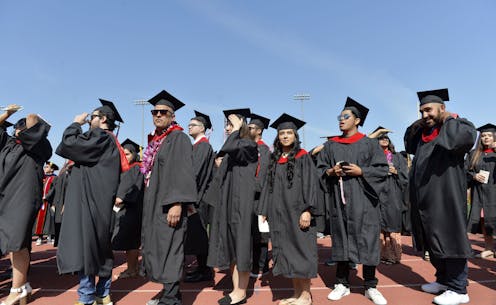What happens when community college is made free
Free community college is touted as a way to make college more accessible. But research shows making community college free comes at a cost to four-year colleges.

Policymakers and presidential hopefuls are having a spirited debate over whether the U.S. should offer free community college, free public college in general or additional college subsidies directed at low-income students.
In a recent paper, my coauthors Chris Avery, Jessica Howell, Matea Pender and I looked at these scenarios.
We found that free community college would increase the number of people graduating with associate degrees, but it would also likely decrease the number of people completing bachelor’s degrees because students would shift away from four-year schools in favor of free tuition.
Community college is already virtually free
For the vast majority of low-income students, community college is already effectively tuition-free. Many students qualify for the maximum annual Pell Grant award, which is currently US$6,195. Even in a high-cost state like New Hampshire – where I live – this would almost cover full-time tuition and fees. In many other states, the Pell Grant is actually greater than the cost of tuition and fees at community colleges.
The College Board estimates that across the U.S. the average sticker price for full-time public two-year college tuition and fees is $3,730. The average net price – that is, what students pay after they get grant and scholarship aid – is negative $430. In other words, students receive the extra amount to pay for books or living expenses.
Students behave differently when they know college is free
Taking into account that actual tuition and fees are already essentially free, could there still be significant effects when students know for certain that their schooling will cost nothing? Yes.
That was the finding of Susan Dynarksi, Katherine Michelmore, Stephanie Owen and C.J. Libassi, of the College Board, in their free college experiment at the University of Michigan.
In the Michigan experiment, researchers contacted low-income, high-achieving students who were likely admissible to University of Michigan to let them know they had four years of guaranteed free tuition and fees. This is aid that the students likely would have received anyway had they taken the usual steps to apply to the University of Michigan and apply for financial aid. But the simplicity of the process and the guarantee increased the number of students who enrolled at the University of Michigan by 15 percentage points. The rate at which students did not enroll in any college fell by four percentage points.
More people go to college when community college is free
Researchers have studied the impacts of announcing that college will be free in Oregon (Gurantz), Tennessee (Carruthers and Fox) and Massachusetts (Goodman and Cohodes).
The potential good news is that more students were drawn into college by the policy. In Tennessee, an additional 2.5 percentage points of each high school graduating year decided to enroll in community college. Yet another 2.5% of the cohort were drawn from four-year institutions into community colleges. This could be seen as a problem because researchers find the likelihood of earning a bachelor’s degree or higher earnings is increased by starting out at more selective institutions with higher graduation rates than community colleges.
The point of my research was to see what would happen if there was a national free community college policy.
My research team found that free community college does boost the overall rate of obtaining an associate degree – from 5.8 to 7.0 percentage points of students that could enroll. But, just as it occurred in Tennessee, bachelor’s degree completion falls by 1 percentage point as students are shifted away from four-year colleges. Low-income students – that is, those with family incomes of less than $40,000 per year – are impacted the least since the true price of attending community college does not change much for these students.
Some of the other policies we examine have better bang for the buck than free community college. Guaranteeing free community college for all would cost about $200 per graduating high school senior. Our research found that using that same $200 per person on increased spending per pupil at public two- and four-year colleges raises the number of students who earn both associate’s and bachelor’s degrees, regardless of their family income. The rate of students who earn bachelor’s degrees would rise by one percentage point.
The increased spending would be for more student support, such as mentors, and increased availability of classes. Such increases in spending can be highly effective at helping students make it through college and to graduation.
Alternatively, making college free at four-year public colleges for students with family incomes of less than $60,000 per year, raises the percentage of low-income students who earn a bachelor’s degree from 25% to 28%, according to our research.
Making a service free to everyone – regardless of income – can be an attractive and simple policy. But targeted polices – like giving free college to those for whom it will do the most good – can often provide a larger positive impact for the same amount of spending.
Bruce Sacerdote does not work for, consult, own shares in or receive funding from any company or organisation that would benefit from this article, and has disclosed no relevant affiliations beyond their academic appointment.
Read These Next
Karoline Leavitt’s White House briefing doublethink is straight out of Orwell’s ‘1984’
A historian analyzes how White House press secretary Karoline Leavitt’s claims about her boss and…
Where the wild things thrive: Finding and protecting nature’s climate change safe havens
Protecting places that are likely to remain cool and moist as global temperatures rise can save wildlife…
Billionaires with $1 salaries – and other legal tax dodges the ultrawealthy use to keep their riches
The richest Americans can largely avoid paying income and other taxes. A new book explains the history.





